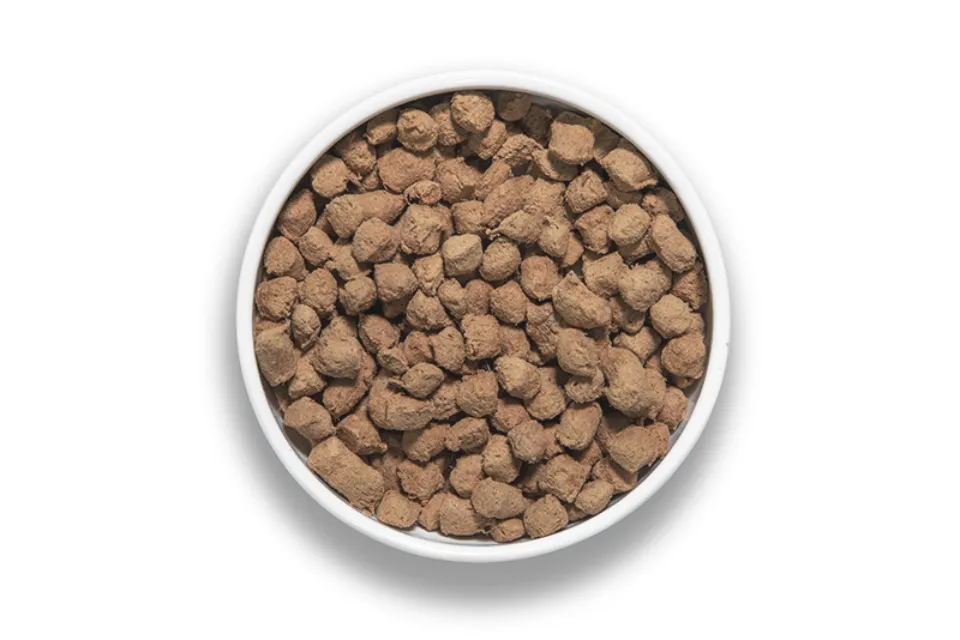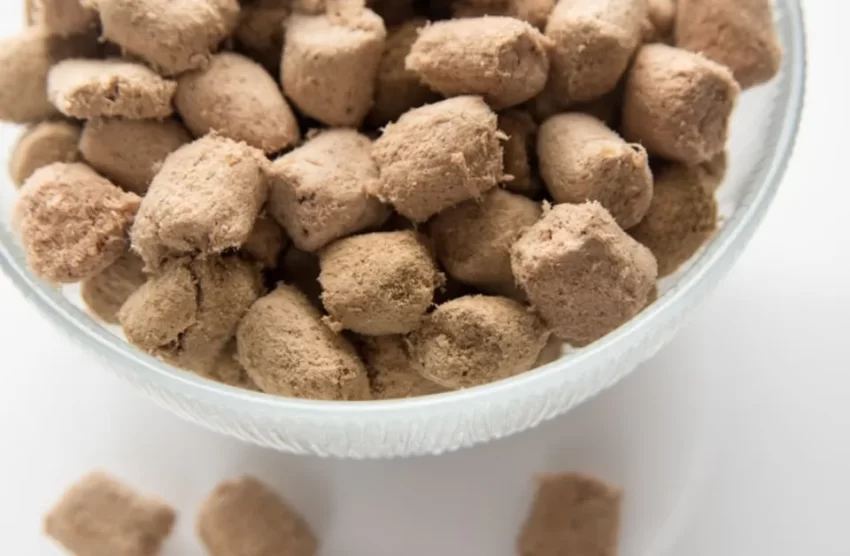Freeze-dried dog food has quickly gained popularity among pet owners among the wide variety of pet food products available on the market. But is freeze-dried food good for dogs?
Freeze-dried dog food provides minimally processed nutrition for dogs which appeals to pet parents seeking an alternative to plain kibble.
In this article, we’ll explain what freeze-dried dog food is, as well as the advantages and drawbacks of giving it to your dog. Following that, we’ll give you our advice on feeding your dog freeze-dried food.
Table of Contents
What is Freeze Dried Dog Food?
Freeze-drying is a technique that preserves raw ingredients such as fresh meat to deliver a finished dog food product which is safe, shelf stable and lightweight.
Technically raw and nutrient-rich, freeze-dried dog food.
Related Post: Can You Freeze Dry Dog Food?
Pros of Freeze-Dried Dog Food

There are two big advantages to freeze-dried raw : it’s raw … and it keeps well. What else about it is good?
Long Shelf Life
Food that has been freeze-dried typically lasts at least a year, and in some cases up to five years. On the package, look for the sell-by date. However, once you open it and let the air in, you’ll typically need to use it within a month. After opening the package, some manufacturers suggest cooling it.
Convenience
It is as practical as kibble because of its longer shelf life and lack of need for a freezer. Not only that, but if you travel with your dog, it’s much simpler to bring along a bag of freeze-dried raw food. Much easier than attempting to fit a large cooler into the vehicle to prevent frozen food from going bad while traveling.
Additionally, because it is so lightweight, freeze-dried food is perfect for camping or backpacking with your dog. Purchase a backpack for your dog so she can carry her own food! Online shopping for freeze-dried food is also simple. It is lightweight and inexpensive to ship. For most frozen raw foods, you’ll need to go to a store … or pay a lot for shipping!
Better Nutrition
Other packaged foods (aside from frozen raw) do not provide as good of nutrition as freeze-dried raw.
Nutrients Aren’t Damaged
The nutrients are mostly still present after freeze-drying, as was previously mentioned. Proteins, amino acids, and other nutrients are kept in meat that has been frozen-dried.
Important substances like probiotics, fats, and enzymes also maintain their quality. That’s helpful because some foods that were freeze-dried had probiotics or added fats. If those didn’t survive the freeze-drying procedure, there wouldn’t be much point in paying for them.
Vitamin C is one nutrient that is actually diminished by freeze-drying. But you shouldn’t worry excessively about that. Dogs don’t typically require vitamin C in their diet because they produce it on their own. When a dog is under stress, ill, or undernourished, their production of vitamin C decreases. Gum bleeding, diarrhoea, loose teeth, and joint pain are all indications of vitamin C deficiency. Therefore, avoid giving ascorbic acid if you occasionally want to give your dog extra vitamin C. Because it is synthetic, it is poorly absorbed. It is preferable to give a dietary supplement or include foods high in vitamin C, such as berries, red peppers, broccoli, and spinach.
Bone
Your dog needs bones because they are a great source of calcium and other minerals. Better freeze-dried dog food contains bones in its ingredients. Artificial minerals will be substituted in lower-quality foods.
No Starch Needed
Foods that are freeze-dried don’t require starch. In fact, some prey model freeze-dried foods only contain the muscle meat, organ meat, and bone in addition to an omega-3 oil like herring.
However, you must exercise caution. There are lots of freeze-dried foods that include starchy ingredients. The cheaper formulas are frequently those. You should steer clear of feeding your dog foods that contain starches. (You avoid kibble in part because of this, am I correct?)
It’s Live Food
Freeze-drying doesn’t “denature” food like cooking does. You can’t “unfry” an egg and you can’t “uncook” your dog’s food. The protein is denatured during any type of cooking. Freeze-dried is a “live” food, just like frozen raw. It’s not a dead food like kibble because freeze-drying doesn’t kill enzymes or bacteria, good or bad.
This is much better for your dog. However, it does imply that you should practice fundamental hygiene, such as washing your hands and wiping down surfaces.
Recall that there is a significant distinction between freeze-dried foods and dehydrated or air-dried foods. Those foods are processed with heat, and that is usually a “kill step” for pathogens. But how can you be certain that freeze-dried foods are secure for your dog, speaking of pathogens?
Freeze-Dried Safety
Similar to feeding frozen raw foods, pick a dish that has premium, ethically sourced ingredients. Therefore, you shouldn’t have to worry about dangerous bacteria in the freeze-dried food your dog eats.
Compared to humans, dogs are much better at tolerating bacteria. Most bacteria that cause illness in humans don’t affect dogs at all because of their digestive systems, which are acidic. Consider the objects your dog snatches and consumes while out for walks. Or in the wild, consuming any long-dead animals they come across.

For both frozen and freeze-dried foods, many manufacturers still go one step further and use high pressure pasteurization (HPP).
In many cases, they have been forced to do so because of the Food Safety Modernization Act’s zero-tolerance policy for bacteria in pet foods (as opposed to the 7% salmonella allowed in chicken from supermarkets). Nevertheless, it indicates that the FDA and some state departments of agriculture have been harshly criticizing raw foods. Many have been forced to make expensive and frequently pointless recalls as a result. Thus, HPP has been embraced by the majority.
HPP is a “kill step” that eliminates pathogens by putting extreme pressure on the food. However, research indicates that there is only a very slight loss of nutrients and that it does not cook the food. Other companies use a “test and hold’ approach. This implies that they hold off on selling a particular batch of food until it has undergone safety testing.
Freeze-Dried May Help the Switch to Raw
Freeze-dried foods can be a good “gateway” to raw feeding.
Kibble can become addictive to dogs. Maybe you tried to switch your dog from kibble to raw food, but she just walked away and looked up at you in disgust! Some freeze-dried foods have the “crunch” of kibble (but without the starches and inferior ingredients).
So, give one of the firmer-textured freeze-dried foods a try and ask her opinion! You could acclimate to a fresh or frozen raw diet over time if she enjoys it.
Clearly, freeze-dried dog food has a lot of benefits. So what’s the catch?
Cons of Freeze-Dried Dog Food
There really is just one, though. And that’s the cost. Freeze-dried can definitely give you sticker shock.
Why is it so pricey? Naturally, the equipment is expensive. However, the freeze-drying procedure itself is also.
The process of freeze-drying is time-consuming and difficult. The price of freeze-dried foods is largely due to this factor. Freeze drying takes time and cannot be rushed. A batch of food takes about 2 days to freeze-dry. Additionally, if they try to rush it, the food may get some moisture back.
Of course, convenience and a long shelf life come at a price. Online freeze-dried food shopping is simple and shipping is reasonably priced or even free. But unless you want to pay a high shipping fee, you’ll have to go to the store personally to purchase frozen raw food.
A 1 lb bag of high-quality freeze-dried products can cost anywhere between $30 and $50. That is a fairly small bag; to save money, purchase larger or bulk quantities.
These costs are comparable to some raw brand prices when the food is rehydrated. They obviously cost a lot more than any kibble or canned food, though. But these high-end freeze-dried foods offer really first-rate nutrition for your dog … without any fillers or potentially harmful ingredients.
And, as with other raw foods … you’ll likely save on vet bills by giving your dog a top-quality diet that supports her health!
How is Dog Food Freeze-dried?
At extremely low temperatures, the process of freeze-drying removes moisture. When raw ingredients are freeze-dried, the water in the food is first turned into vapor by first being frozen, and then the ingredients are placed in a powerful vacuum.
Some freeze dried foods you may already be buying for yourself include instant coffee and cereal with freeze dried berries.
How Does Freeze-drying Impact the Nutritional Content of the Food?
In comparison to other techniques like cooking or dehydrating pet food, freeze-drying preserves a greater portion of the nutritional value of the raw ingredients.
It helps to preserve the wholesome nutrition that is naturally present because the raw meat ingredients are freeze-dried.
Related Reading: Do Freeze-Dried Foods Have The Same Nutritional Value?
Conclusion: is Freeze Dried Food Good for Dogs
Dog food is now offered in a huge selection of packaging, flavors, and forms. due to the recent increase in popularity of freeze-dried dog food.
Freeze-dried dog food is made of raw nutritional ingredients like beef, salmon, chicken and more that is frozen at peak freshness.
This is a great choice. Although it is pricey, there are many advantages. The best kind of nutrition for your dog is actually freeze-dried. And we all want that for our closest friends.
Also Read:
FAQs
Is Freeze-dried Dog Food Better Than Kibble?
Dehydrated foods are still much better than kibble. They lose fewer nutrients because they’re less processed and cooked at lower temperatures.
How to Feed Freeze-dried Dog Food?
You can feed freeze-dried foods directly or rehydrate them with warm water. Wait a few minutes before serving the food after adding water.
Can I Mix Freeze-dried With Kibble?
Yes, you can absolutely do it! In fact, incorporating raw foods in any way you can, even in small amounts, is highly advised.

